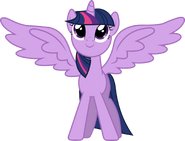A winged unicorn (or flying unicorn Also known as Alicorn, Alaricorn and Unipegasus) is a fictional horse with wings and a horn, and may be a variant from either the more well known Pegasus, and/or unicorn.
This creature has no specific name, but in some literature and media, it has been referred to as an Alicorn - a Latin word for the horn of a unicorn, especially in alchemical texts.[1] These creatures may also sometimes be called a Unipeg or a pegacorn, both a portmanteau of pegasus and unicorn.
Myths & Legends[]
Appearance[]
Winged unicorns have often been depicted in art. As a mythical horse, is commonly depicted as having a white coat and wings, but can come in other colors. It is, at its core, a horse with feathery wings similar to a Pegasus, and a horn on its forehead like a Unicorn.
Connections with Destruction and Evil[]
Ancient Assyrian seals generally depicted winged unicorns (and winged bulls) as representives of evil. Due to these depictions relating the Alicorn to evil or at least destructive behavior, it is possible it is more closely related to the Bicorn.
In a few contrasting cases, some winged unicorns represented (or at least sided with) light.
Origins[]
The Achaemenid Assyrians made Alicorns a representation of evil and darkness (and only occaisionally light) on their engraved seals.[2][3]
Irish poet W. B. Yeats specifically wrote of a winged unicorn in his 1907 play The Unicorn from the Stars, which is often considered one of the main introductions of this creature into culture and myth.
- Additionally, some compare the "brazen winged beast...associated with laughing, ecstatic destruction" described by Yeats in the introduction of "The Resurrection" (a short prose play comparing 3 worldviews of different religions/cultures) as a winged unicorn. Later, Yeats explained that this "brazen winged beast" was the same as the "rough beast...[that] Slouches towards Bethlehem" found in his poem "The Second Coming".[4] However, as this beast is described in "The Second Coming" as having the body of a lion, it more likely that this beast is question is more likely a Sphinx, rather than an Alicorn.
Modern Depictions[]
These creatures are commonly found on carousels and other modern structures.
Films & Animations[]
- These creatures are very well-known for appearing in the cartoon series My Little Pony: Friendship is Magic, especially as royalty.
- The Alicorn with rainbow coloration named "Swift Wind" is found in the animated series of She-Ra
Video Games[]
- The Dark Pegasi from Warhammer are similar in that they are horses with wings (albeit leathery ones) and multiple horns on their forehead.
- The "Falcon Knights" in the Fire Emblem series are known for riding these creatures.
References[]
- ↑ Shepard, Odell (1930). the Lore of the Unicorn. London: Unwin and Allen. ISBN: 9781437508536 .
- ↑ Brown, Robert (2004). The Unicorn: A Mythological Investigation. Kessinger Publishing. p. 18. ISBN: 9780766185302 .
- ↑ Von Der Osten, Hans Henning (June 1931). "The Ancient Seals from the Near East in the Metropolitan Museum: Old and Middle Persian Seals". The Art Bulletin. 13 (2): 221–41. JSTOR 3050798.
- ↑ Ward, David (Spring 1982). "Yeats's Conflicts with His Audience, 1897–1917". ELH. 49 (1): 155–6. JSTOR 2872885.









